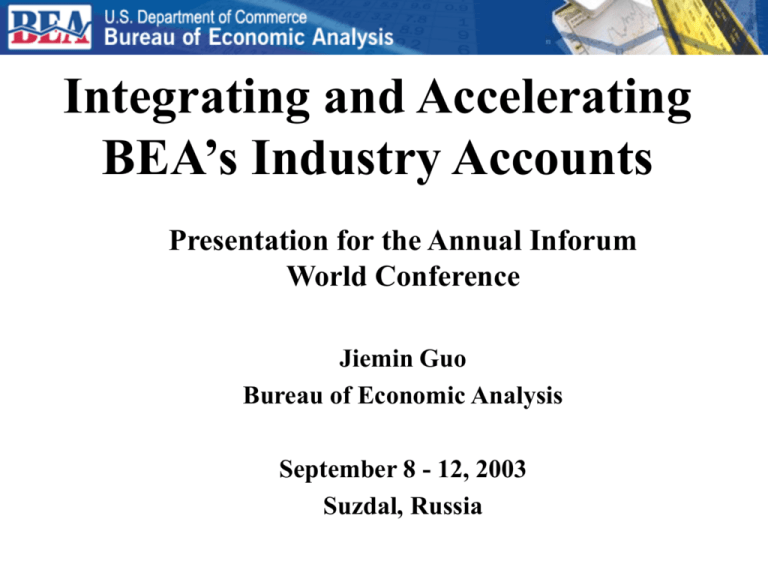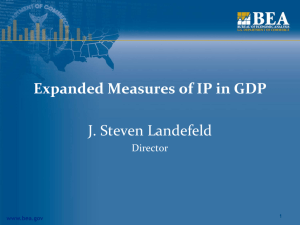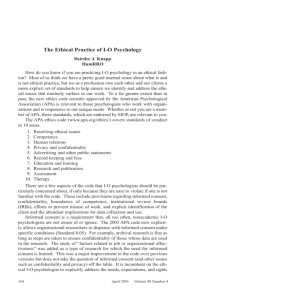Integrating and Accelerating BEA's Industry Accounts
advertisement

Integrating and Accelerating BEA’s Industry Accounts Presentation for the Annual Inforum World Conference Jiemin Guo Bureau of Economic Analysis September 8 - 12, 2003 Suzdal, Russia Outline • • • • BEA’s vision for integrating the accounts Methodologies for integration Steps for integration Products www.bea.gov BEA Accounts Three approaches to estimate GDP 1. Expenditures approach: GDP = C + I + G + (X - M) 2. Income approach: GDP = Compensation of employees + property-type income + indirect business taxes 3. Production approach: GDP = Gross output - intermediate inputs www.bea.gov BEA’s Vision for Integrating the Accounts • Long-term: Full Integration (2008-2010) – Integration of all industry accounts and integration of industry accounts with the national income and product accounts (NIPA’s) – Provide a third approach to measure GDP • Short-term: Partial Integration (2004-2007) – Integration of the Annual I-O and GDP-byindustry accounts www.bea.gov Value Added Estimates Depend on Quality of Data I-O accounts • Value added = Gross output intermediate inputs • Quality of gross output is high, but overall quality of intermediate inputs is not. GDP-by-industry accounts • Value added = Compensation of employees + property type income + IBT • Quality depends on source data; property type income is most troublesome www.bea.gov Partial Integration: Four Steps to Integrate Industry Accounts • Develop 1997 “Prime” benchmark table • Develop time series of gross output and value added by industry • Apply I-O framework to develop time series of annual I-O accounts • Develop real (inflation adjusted) measures www.bea.gov Step 1: Develop 1997 “Prime” Benchmark I-O Table • Incorporate results of 2003 NIPA revisions • Options for setting best levels of value added – Use results “as is” from the 1997 Benchmark I-O accounts – Use results “as is” from the GDP-by-industry accounts – Straight average of results from the 1997 Benchmark I-O and GDP-by-industry accounts – Incorporate the best estimates from both sets of accounts www.bea.gov Merging Information for Setting Value-Added Levels Benchmark Value Added GDP-byIndustry Value Added Poor Benchmark data / good GDP-by-industry data e.g., Transportation/ Warehousing Poor Benchmark data/ poor GDP-by-industry data e.g., Construction Good Benchmark data / good GDP-by-industry data e.g., Health care Good Benchmark data/ poor GDP-by-industry data e.g., Mining www.bea.gov Evaluation Criteria: (1) Benchmark I-O Accounts • Percent intermediate inputs by industry covered by Census Bureau • Share of an industry’s data provided by Census Bureau • Share of industry estimates added to balance the I-O table www.bea.gov Evaluation Criteria: (2) GDP by Industry Accounts • Quality of establishment-based components of GDI – Company-establishment adjustments • Stability of implied I-O ratio • Consistency between IRS-based and Census-based source data www.bea.gov Merging Information from I-O & GDP by Industry Accounts • Based on our criteria: – Develop expected ranges of the I-O and GDP by industry measures of value added for each industry – Combine the two distributions to get the “best” estimate of value added www.bea.gov Paper Manufacturing: Probability Distribution of Other Value Added from Combined Information 80 Percent Confidence Intervals I-O: Combined [17,393, 20,706] GDP-by-Ind: [17,559, 19,848] 0.0003 Combined: [17,873, 19,746] Medians I-O: 19,057 GDP-by-Ind: 18,693 Combined: 18,808 0.0002 GDP-by-Industry I-O 0.0001 0.0000 8500 11000 13500 16000 18500 21000 Millions of Dollars 23500 26000 www.bea.gov Step 2: Time Series of Gross Output and Value Added by Industry • Benchmark gross output and value added to 1997 Prime benchmark I-O table • Extrapolate gross output by industry using data from Census Bureau • Develop time series value added by industry from 1997 prime level, using either gross output extrapolators or GDI extrapolators www.bea.gov Step 3: Develop Time-series of Balanced Annual I-O Accounts • Prepare annual I-O tables, given initial estimates of gross output, value added, and final demand • Balance annual tables to establish consistency between gross output and value added by industry, GDP by industry, and I-O relationships www.bea.gov Input-Output Use Table INDUSTRIES Agriculture Mining Constructi on Manufactur Transporta ing tion Trade FINAL USES (GDP) Finance Services Other Total Intermediate Use PCE PFI CBI X M GOVT GDP TO TAL CO MMO DITY O UTPUT Agriculture Minerals C O M M O D I T I E S Construction Manufacturing Transportation Trade Finance Services Other Noncomparable imports Total Intermediate inputs COMP VALUE ADDED IBT Other value added Total TOTAL INDUSTRY OUTPUT www.bea.gov Step 4: Develop Real Measures • Apply double deflation procedure to time series of balanced annual I-O tables • Real GDP growth based on expenditures approach consistent with real GDP growth based on double deflation procedure www.bea.gov Products • Spring 2004: – Integrated annual I-O and GDP-by-industry accounts – Accelerated annual I-O accounts • 2007: – 2002 benchmark I-O accounts • 2008: – Move to full integration from 2002 benchmark I-O accounts www.bea.gov







